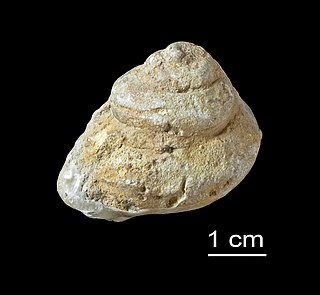Chippewaella patellitheca is a stem-gastropod mollusc from Furongian-aged strata of Late Cambrian Wisconsin. According to Peter J. Wagner, it is the most basal gastropod.
Strepsodiscus is an extinct genus of very primitive fossil snail-like molluscs from the early part of the Late Cambrian of North America. The coiled, slightly asymmetrical shells are about 3 cm in height. It is not known whether these are shells of gastropods or monoplacophorans, which are more primitive mollusks.

The siphonal canal is an anatomical feature of the shells of certain groups of sea snails within the clade Neogastropoda. Some sea marine gastropods have a soft tubular anterior extension of the mantle called a siphon through which water is drawn into the mantle cavity and over the gill and which serves as a chemoreceptor to locate food. Siphonal canals allow for active transport of water to sensory organs inside the shell. Organisms without siphonal canals in their shells rely on passive or diffuse transport or water into their shell. Those with siphonal canals have a direct inhalant stream of water that interacts with sensory organs to detect concentration and direction of a stimulus, such as food or mates. In certain groups of carnivorous snails, where the siphon is particularly long, the structure of the shell has been modified in order to house and protect the soft structure of the siphon. Thus the siphonal canal is a semi-tubular extension of the aperture of the shell through which the siphon is extended when the animal is active.

Scenella is an extinct genus of fossil invertebrate animal which is generally considered to be a mollusc; at various times it has been suggested that this genus belongs with the gastropods, the monoplacophorans, or the helcionellids, although no firm association with any of these classes has been established. An affinity with the hydrozoa has been considered, although some authors oppose this hypothesis. A gastropod affinity is defended on the basis of six pairs of internal muscle scars, whilst the serially-repeated nature of these scars suggests to other authors a monoplacophoran affinity. However the specimens showing this scarring have not been convincingly shown to belong to the genus Scenella. A similarity to the Ediacaran Ovatoscutum has also been drawn.

Platyceras is a genus of extinct Paleozoic sea snails, marine gastropod mollusks in the family Platyceratidae. This genus is known from the Silurian to the Middle Triassic periods and especially abundant in the Devonian and Carboniferous. It is the type genus of the family Platyceratidae.

Platyceratidae is an extinct family of Paleozoic sea snails, marine gastropod mollusks. This family may belong in the Patellogastropoda or the Neritimorpha.
Trypanaxidae is an extinct family of fossil sea snails, marine gastropod molluscs in the superfamily Campaniloidea.

Lesueurillidae is an extinct family of paleozoic molluscs (gastropods?) with anisostrophically coiled shells of uncertain position (Gastropoda?).
Isospiridae is an extinct family of fossil sea snails, Paleozoic gastropod mollusks.

Loxonematoidea is an extinct taxonomic superfamily of sea snails, marine gastropod molluscs, belonging to the Murchisoniinae.
Plagiothyridae is an extinct family of fossil sea snails, marine gastropod mollusks in the superfamily Neritopsoidea.
Amphiscapha is a fossil gastropod mollusk, or less likely a monoplacophoran, genus from the Pennsylvanian and Lower Permian of North and South America, included in the family Euomphalidae. It is sometimes regarded as a subgenus of Straparollus, S. (Amphiscapha) Knight 1942

Ampullina is an extinct taxonomic genus of deep-water sea snails, marine gastropod molluscs in the clade Caenogastropoda. These sea snails were epifaunal grazers. They lived from the Middle Triassic period to the Lower Pliocene age.

Ampullinopsis is an extinct taxonomic genus of deep-water sea snails, marine gastropod molluscs in the clade Sorbeoconcha. These sea snails were epifaunal grazers. Sea snails of this genus lived from Paleocene epoch to Miocene epoch.

Holopea is an extinct genus of fossil sea snails, Paleozoic gastropod mollusks in the family Holopeidae.

Velates is an extinct genus of marine gastropod mollusks belonging to the family Neritidae.
Cypraedia is an extinct genus of gastropods.
Caestocorbula is an extinct genus of saltwater clams in the family Corbulidae. The name has been created for fossils from the Eocene of Belgium.
Phragmolites is an extinct genus of molluscs in the family Bucaniidae, paleozoic molluscs of uncertain position possibly being either Gastropods or Monoplacophorans in the superfamily Bellerophontoidea.
Calliomphalus is an extinct genus of sea snails in the family Eucyclidae.









